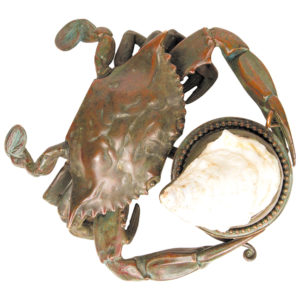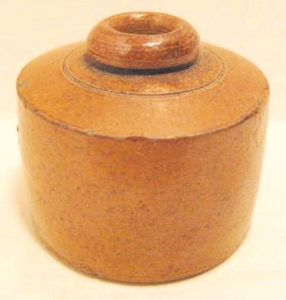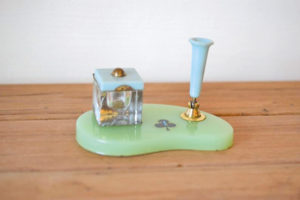 By Anne Gilbert
By Anne Gilbert Old inkwells and inkstands may not be used these days for their original purpose but have been rediscovered as decorative and collectible. While common, utilitarian pieces can be had for one hundred dollars or less, unique examples are pricey. A good example is an art Nouveaus, patinated bronze, 1905 Tiffany Studios inkwell cast as a crab. The well has a seashell lid. It currently has a dealer price of $27,500. They can be several hundred years old or made in the early 20th century. Surprisingly even 18th century examples of fragile pottery and porcelain have survived. Many are so beautiful they could be classified as an art form. Others were simple designs of glass and wood . Most common are the 19th century stands of iron with glass wells.
Historically, the use of early writing implements and ink date to the beginnings of civilization but actual writing wasn’t done by private individuals till the 16th century. A few Italian and Majolica inkstands dating as early as the 1500s have survived. France, Germany and Holland began making inkstands and wells similar to Majolica during the 16th century. They are known as Delft and Delft type.
By the 18th century every desk of the moneyed class boasted an inkwell and/or inkstand. The materials were varied from sterling silver to bronze, brass, porcelain to glass. The finest examples by important goldsmiths were given as gifts on special occasions and as presentation pieces. When they were custom painted, when made in China they became known as export china.
 By the end of the 19th century wealthy Americans and Europeans topped their desks with writing sets made by Tiffany or French figural bronzes combined with Baccarat crystal. At that time they often came with desk accessories such as letter holders, calendars and blotters.
By the end of the 19th century wealthy Americans and Europeans topped their desks with writing sets made by Tiffany or French figural bronzes combined with Baccarat crystal. At that time they often came with desk accessories such as letter holders, calendars and blotters. CLUES: Some ways to identify age and country of early inkwells and stands are material, styles and shape. 18th century inkstands were casket shape with an enclosed inkpot. Others were tray form with bullet feet. Like their silver counterparts, English silver examples followed the prevailing fashion. 18th century followed the rococo style using scrolled and reeded rims as did the French.
A quaint custom was developed in 18th century America. The silver stands, combined with cut glass (later pressed) inkpots came with a tiny bell. This alerted servants that the mail was ready to be sent off.
As in all collecting categories there are reproductions. Beware of English brass inkstands and wells, Bennington pottery-types and Sandwich glass style wells.
There are still bargains to be had in Arts and Crafts pieces and carved Black Forest novelty types.
PHOTO CAPTIONS: (1) Art Nouveau crab form inkwell. PHOTO CREDIT: 1stdibs PHOTO CAPTION: (2) 1890 stoneware pottery inkwell PHOTO CREDIT: Ebay PHOTO CAPTION : (3) 1950s Bakelite inkstand. PHOTO CREDIT: funkiflamgoacy
















Follow Us